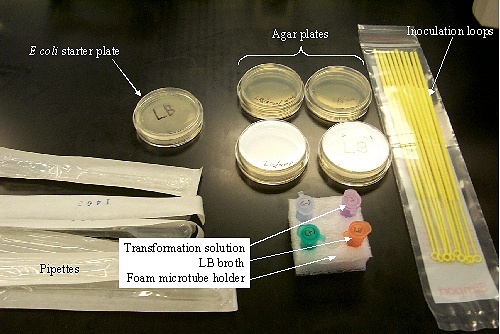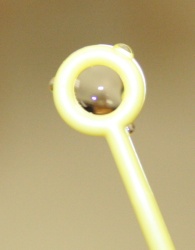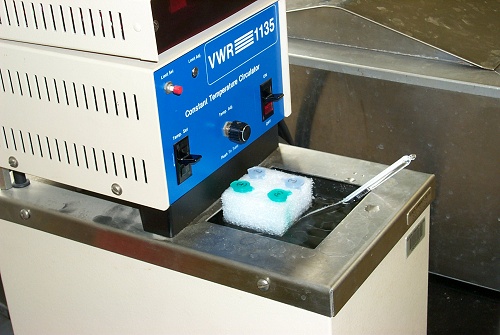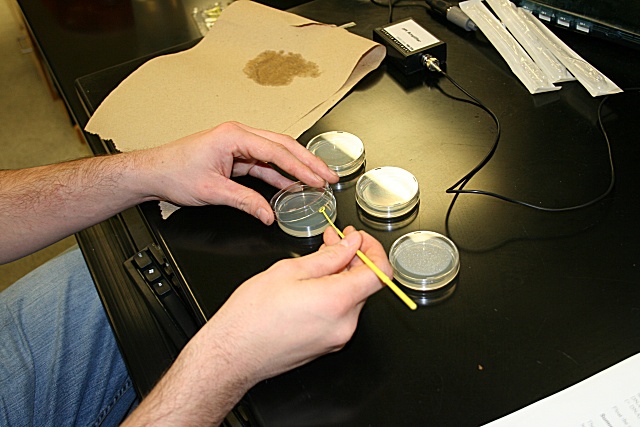Bacterial Transformation
- Page ID
- 2860
Introduction
Biotechnology refers to technology used to manipulate DNA. The procedures are often referred to as genetic engineering.
DNA is the genetic material of all living organisms and all organisms use the same genetic code. Genes from one kind of organism can be transcribed and translated when put into another kind of organism.
For example, human and other genes are routinely put into bacteria in order to synthesize products for medical treatment and commercial use. Human insulin, human growth hormone, and vaccines are produced by bacteria.
Recombinant DNA refers to DNA from two different sources. Individuals that receive genes from other species are transgenic.
Vectors
Vectors are DNA used to transfer genes into a host cell.
Plasmids can be used as vectors to transform bacteria. The host bacterium takes up the plasmid, which includes the foreign gene.
Marker genes can be used to determine if the gene has been taken up. Marker genes must have some distinguishable characteristic. For example if you put a gene that enables an ampicillin resistance on the same vector as the same vector as the gene for green fluorescent protein, then any bacteria that grow on an ampicillin plate will also have the gene for green fluorescent protein. Bacteria that do not have the gene will not survive on these plates.
The pGLO Plasmid
The plasmid used in this exercise has been modified by removing the structural genes of the arabinose operon (ara A, ara B, and ara D). These genes were replaced by a gene from a bioluminescent jellyfish that codes for the production of green fluorescent protein (GFP). This protein glows when it is illuminated by UV light. Because this gene is adjacent to the arabinose promoter, it becomes active in the presence of arabinose. The modified plasmid is called pGLO.
The pGLO plasmid also contains a gene that enables the bacterium to be resistant to the antibiotic ampicillin. Bacteria that have taken up this plasmid are capable of growing on media that contain ampicillin.
Materials Needed
The following equipment will be needed for each group:
1 E. coli starter plate
4 agar plates:
1 LB plate
2 LB/amp plates
1 LB/amp/ara plate
4 microtubules (ignore the colors of the tubules):
1 microtubule containing transformation solution
1 microtubule containing LB broth
1 empty microtube labeled + (or + DNA)
1 empty microtube labeled - (or - DNA)
1 foam microtube holder
1 container with ice water
1 package of. inoculation loops
1 micropipette capable of measuring 250 ul and micropipette tips
1 micropipette capable of measuring 100 ul and micropipette tips

Procedure
Add Transformation Solution (CaCl2)
The foam microtube holder contains a microtube with transformation solution labeled T.S. This tube is shown in the diagram above. Use a micropipette to transfer 250 ul of transformation solution from the TS tube in your foam holder to the tube labeled +DNA and another 250 ul to the tube labeled -DNA.
Place the tubes back in the foam microtube holder and then float all four of the tubes in a container of ice water for 2 minutes.

Add Bacteria
Use a sterile loop to pick up several colonies of bacteria from the starter plate. This can be done by dragging the loop across the plate so that it lightly scrapes the colonies off the surface. Transfer the bacteria to the + DNA tube by spinning the loop rapidly after it is immersed in the liquid.
Repeat this procedure by transferring several colonies of bacteria to the - DNA tube.
Add DNA
Your instructor will provide you with a bottle containing plasmid DNA. Immerse a sterile loop into the bottle containing plasmid DNA. When the center of the loop is coated with a soap-like film, transfer it the + DNA microtube (see photograph below). Use a new sterile loop to transfer a second loopful of plasmid DNA into the same (+ DNA) microtube. The - DNA microtube will not receive any plasmid DNA.

Float the two tubes in their foam holder in ice water for 10 minutes.
Summary
The + DNA tube contains bacteria and DNA from another source. The - DNA tube contains only bacteria.
While Waiting...
While waiting for the tubes to cool, use a marker to label your agar plates with a letter that indicates the type of bacteria that they will receive.
| Plate | Label | Comments |
| LB/amp | + | this plate will receive transformed bacteria |
| LB/amp/ara | + | this plate will receive transformed bacteria |
| LB/amp | - | this plate will receive normal, untransformed bacteria |
| LB | - | this plate will receive normal, untransformed bacteria |
Heat Shock
Heat shocking is used to make the E. coli cells more permeable so that they take up the modified plasmids more readily.
Bring your container of ice water and the microtubes to the 42 degree water bath.
Transfer the foam microtube holder containing the + and - tubes to a 42 degree C water bath for exactly 50 seconds then return the tubes to ice and water. It is important that this heat shock last for exactly 50 seconds. In order to insure that the time is exactly correct, have one person time the procedure while another transfers the tubes to the water bath and returns them when 50 seconds has elapsed.

Allow the tubes to remain in the ice water for 2 minutes.
Remove the foam microtube holder containing the microtubes from the ice water and place it on your bench top. Add 250 ul of LB broth to each of the bacterial cultures (the + tube and the - tube) with a micropipette.
Allow the tubes to stand at room temperature for 10 minutes.
Transfer Bacteria to the Culture Plates
Mix the contents in each of the tubes by tapping them with the fingernail of your index finger.
Transfer 100 ul of the solution from the + microtubule to the surface of the agar of one of the plates labeled + using a micropipette. Transfer 100 ul to the other plate labeled +. When you are finished, each of the plates labeled + will have 100 ul of bacteria from the + tube.
Use a different pipette tip to transfer 100 ul of solution from the - microtubule to the surface of the agar in one of the plates labeled -. Transfer 100 ul to the other plate labeled -.
Spread the mixture over the entire surface of the agar in one of the plates using a sterile loop. Use different sterile loops to spread the mixtures in the other plates. The diagram below shows sterile technique.

Incubate the Plates
Turn the plates over so that the agar is up and the cover is on the bottom side. Stack them one on top of the other and then tape them together. Write your name on the tape.
Your instructor will transfer your plates to the 37 degree incubator in the Microbiology Laboratory. They will remain in the incubator for 24 to 48 hours.
Disposal and Clean-up
The used loops, used pipettes, foam holder, and microtubules should be disposed in a biohazard container. The agar plate containing bacteria that you used for your initial culture should also be disposed in a biohazard container.
The surface of your work area should be sprayed with disinfectant and wiped down with paper towels.
Don't forget to wash your hands before leaving the lab.
Day 2 - Data Collection and Summary
Record your results in your notebook.
For each plate explain why there should be growth or no growth and why it should glow or not glow. A table like the one below should be included in your notebook.
| Why should there growth or no growth? | Why should there be glowing or no glowing? | ||
- |
|
||
- |
LB/AMP |
||
+ |
LB/AMP |
||
+ |
LB/AMP/ARA |

